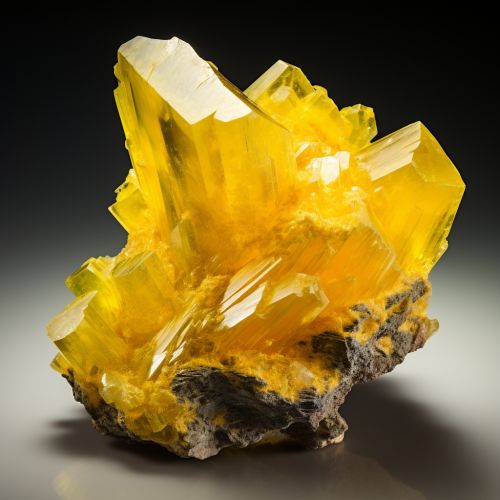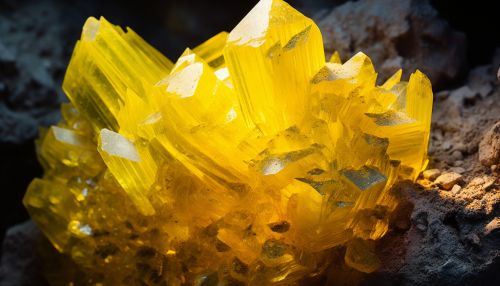Sulfur
Introduction
Sulfur or sulphur (British English) is a chemical element with the symbol S and atomic number 16. It is abundant, multivalent, and nonmetallic. Under normal conditions, sulfur atoms form cyclic octatomic molecules with a chemical formula S8. Elemental sulfur is a bright yellow, crystalline solid at room temperature.
Characteristics
Sulfur is the tenth most common element by mass in the universe, and the fifth most common on Earth. Though sometimes found in pure, native form, sulfur on Earth usually occurs as sulfide and sulfate minerals. Being abundant in native form, sulfur was known in ancient times, being mentioned for its uses in ancient India, ancient Greece, China, and Egypt. Sulfur is referred to in the Bible as brimstone.
Physical Properties
Sulfur forms polyatomic molecules with different chemical formulas, the best-known allotrope being octasulfur, cyclo-S8. The point group of cyclo-S8 is D4d and its dipole moment is 0 D. Octasulfur is a soft, bright-yellow solid that is odorless, but impure samples have an odor similar to that of matches. The structure of the S8 ring is virtually unchanged by this phase change, which affects the intermolecular interactions. Between its melting and boiling temperatures, sulfur changes its state from eight-membered rings to chains. At higher temperatures, the viscosity decreases as depolymerization occurs. Sulfur vapor is greenish yellow and the light emitted is green.
Chemical Properties
Sulfur burns with a blue flame concomitant with formation of sulfur dioxide, notable for its peculiar suffocating odor due to dissolving in water to form sulfurous acid. Sulfur is insoluble in water but soluble in carbon disulfide and, to a lesser extent, in other nonpolar organic solvents, such as benzene and toluene. The first and second ionization energies of sulfur are 999.6 and 2252 kJ/mol, respectively. Despite such figures, the +2 oxidation state is rare, with +4 and +6 being more common. The fourth and sixth ionization energies are 4556 and 8495.8 kJ/mol, the magnitude of the figures caused by electron transfer between orbitals; these states are only stable with strong oxidants such as fluorine, oxygen, and chlorine.
Occurrence
On Earth, just as on Jupiter's moon Io, elemental sulfur occurs naturally in volcanic emissions, including emissions from hydrothermal vents. Sulfur compounds, such as hydrogen sulfide and sulfur dioxide, are produced during the decomposition of organic materials and the heating of sulfur-containing minerals. Sulfur is found in many types of meteorites and is a component of the amino acids cysteine and methionine. It is also found in several vitamins, such as biotin and thiamine, and the coenzyme glutathione.
Production
Sulfur is extracted from underground deposits by the Frasch process, in which superheated water is pumped into the deposits, melting the sulfur and allowing it to be pumped to the surface. It is also recovered from natural gas and oil, where it is found as hydrogen sulfide. The Claus process is used to extract sulfur from these sources.
Applications
Sulfur is used in the manufacture of fertilizer, sulfuric acid, and detergents. It is also used in the vulcanization of rubber, the production of black gunpowder, and the manufacture of insecticides and pharmaceuticals. Sulfur is also used in the production of sulfur hexafluoride, which is used as an insulating medium in high-voltage switchgear.
Biological Role
Sulfur is an essential element for all life, but almost always in the form of organosulfur compounds or metal sulfides. Three amino acids (cysteine, cystine, and methionine) and two vitamins (biotin and thiamine) are organosulfur compounds. Many cofactors also contain sulfur, including glutathione and thioredoxin and iron–sulfur proteins. Disulfides, S–S bonds, confer mechanical strength and insolubility of the protein keratin, found in outer skin, hair, and feathers, and the element is found in virtually all tissues in humans.
Safety
Elemental sulfur is considered to be of low toxicity, but it may cause irritation to the skin, eyes, and respiratory tract. It may also cause gastrointestinal distress if ingested. Sulfur dioxide and hydrogen sulfide are more harmful and can be lethal in high concentrations.
See Also


